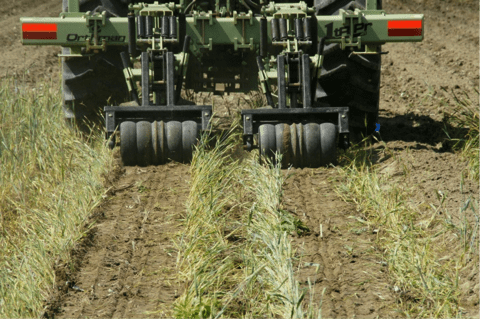
strip till.png
Strip-Till: Precision Cultivation for Soil Health
Definition:
Strip-till is an advanced tillage technique that combines elements of conventional tillage and no-till farming. In strip-till systems, narrow strips of soil are tilled or disturbed where crops will be planted, while the remaining soil between the strips is left untilled. This approach minimizes soil disturbance while providing an optimal seedbed for crop establishment.
The Principles of Strip-Till:
Strip-till systems are based on the principles of minimal soil disturbance, precision farming, soil cover, and nutrient management. By concentrating tillage in narrow strips, strip-till farmers aim to reduce erosion, conserve moisture, improve soil structure, and enhance the efficiency of fertilizer and nutrient application.
Fall off the barn roof and busted your keister? Life on the farm or ranch can be tough on the bum. Need a break? Laugh it off at FarmerCowboy.com, the #1 farm humor site. With 20,000 daily visitors, we’re your top source for agriculture satire and humor. Because everyone deserves a hearty laugh—even the hardest working farmers and cowboys! Join us and turn those long days into fun tales at FarmerCowboy.com.
Implementation of Strip-Till:
Strip-till involves several key steps, including:
- Strip Preparation: Prior to planting, narrow strips or rows are tilled or cultivated using specialized strip-till equipment. This creates a seedbed for crop establishment while leaving the majority of the field untilled.
- Precision Placement: After strip preparation, seeds are planted directly into the tilled strips using precision planting equipment. This ensures accurate seed placement, optimal seed-to-soil contact, and uniform crop emergence.
- Residue Management: Crop residues from previous crops are typically left on the soil surface or incorporated into the tilled strips to provide soil cover, reduce erosion, and enhance soil organic matter content.
Benefits of Strip-Till:
Strip-till offers numerous benefits for soil health, water conservation, nutrient management, and farm profitability, including:
- Soil Conservation: By minimizing soil disturbance and maintaining soil cover, strip-till reduces erosion, preserves soil structure, and enhances soil health and productivity over time.
- Water Management: Strip-till systems improve water infiltration, reduce runoff, and enhance soil water retention, helping to mitigate the impacts of drought and water scarcity.
- Nutrient Efficiency: Strip-till allows for precise placement of fertilizer and nutrients in the tilled strips, optimizing nutrient uptake by crops and reducing nutrient losses to the environment.
- Weed Control: The tilled strips in strip-till systems provide a clean seedbed for crop establishment while suppressing weed growth, reducing the need for herbicides and weed management interventions.
- Time and Labor Savings: Strip-till systems require fewer passes with tillage equipment compared to conventional tillage, saving time, fuel, and labor costs for farmers.
Challenges and Considerations:
Despite its numerous benefits, the adoption of strip-till may face challenges related to equipment costs, weed management, crop residue management, and farmer education and support. Addressing these challenges requires collaborative efforts among farmers, researchers, policymakers, and agricultural stakeholders to promote the widespread adoption and implementation of strip-till practices.
Conclusion:
In conclusion, strip-till represents a precision cultivation technique that combines the benefits of reduced soil disturbance with the advantages of conventional tillage. By embracing the principles of strip-till, farmers can protect soil resources, enhance crop productivity, and promote the long-term sustainability of agricultural systems.
References:
- United States Department of Agriculture. (2020). Strip-Till. https://www.nrcs.usda.gov/wps/portal/nrcs/main/national/programs/soilhealth/striptill/
- Soil and Water Conservation Society. (n.d.). Strip-Till. https://www.swcs.org/resources/strip-till/
- Sustainable Agriculture Research & Education. (n.d.). Strip-Till. https://www.sare.org/Learning-Center/Books/Building-Soils-for-Better-Crops-3rd-Edition/Text-Version/Strip-Till/
Originally posted 2014-03-21 21:42:45.
Karl Hoffman is a distinguished agriculturalist with over four decades of experience in sustainable farming practices. He holds a Ph.D. in Agronomy from Cornell University and has made significant contributions as a professor at Iowa State University. Hoffman’s groundbreaking research on integrated pest management and soil health has revolutionized modern agriculture. As a respected farm journalist, his column “Field Notes with Karl Hoffman” and his blog “The Modern Farmer” provide insightful, practical advice to a global audience. Hoffman’s work with the USDA and the United Nations FAO has enhanced food security worldwide. His awards include the USDA’s Distinguished Service Award and the World Food Prize, reflecting his profound impact on agriculture and sustainability.







Too good! I had to share it! ??